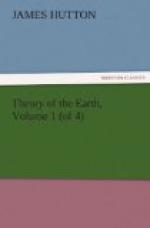We are now, in reasoning from principles, come to a point decisive of the question, and which will either confirm the theory, if it be just, or confute our reasoning, if we have erred. Let us, therefore, open the book of Nature, and read in her records, if there had been a world bearing plants, at the time when this present world was forming at the bottom of the sea.
Here the cabinets of the curious are to be examined; but here some caution is required, in order to distinguish things perfectly different, which sometimes are confounded.
Fossil wood, to naturalists in general, is wood dug up from under ground, without inquiring whether this had been the production of the present earth, or that which had preceded it in the circulation of land and water. The question is important, and the solution of it is, in general, easy. The vegetable productions of the present earth, however deep they may be found buried beneath its surface, and however ancient they may appear, compared with the records of our known times, are new, compared with the solid land on which they grew; and they are only covered with the produce of a vegetable soil, or the alluvion of the present land on which we dwell, and on which they had grown. But the fossil bodies which form the present subject of inquiry, belonged to former land, and are found only in the sea-born strata of our present earth. It is to these alone that we appeal, in order to prove the certainty of former events.
Mineralised wood, therefore, is the object now inquired after; that wood which had been lodged in the bottom of the sea, and there composed part of a stratum, which hitherto we have considered as only formed of the materials proper to the ocean. Now, what a profusion of this species of fossil wood is to be found in the cabinets of collectors, and even in the hands of lapidaries, and such artificers of polished stones! In some places, it would seem to be as common as the agate.
I shall only mention a specimen in my own collection. It is wood petrified with calcareous earth, and mineralised with pyrites. This specimen of wood contains in itself, even without the stratum of stone in which it is embedded, the most perfect record of its genealogy. It had been eaten or perforated by those sea worms which destroy the bottoms of our ships. There is the clearest evidence of this truth. Therefore, this wood had grown upon land which flood above the level of sea, while the present land was only forming at the bottom of the ocean.
Wood is the most substantial part of plants, as shells are the more permanent part of marine animals. It is not, however, the woody part alone of the ancient vegetable world that is transmitted to us in the record of our mineral pages. We have the type of many species of foliage, and even of the most delicate flower; for, in this way, naturalists have determined, according to the Linnaean system, the species, or at least the genus, of the plant. Thus, the existence of a vegetable system at the period now in contemplation, so far from being doubtful, is a matter of physical demonstration.




